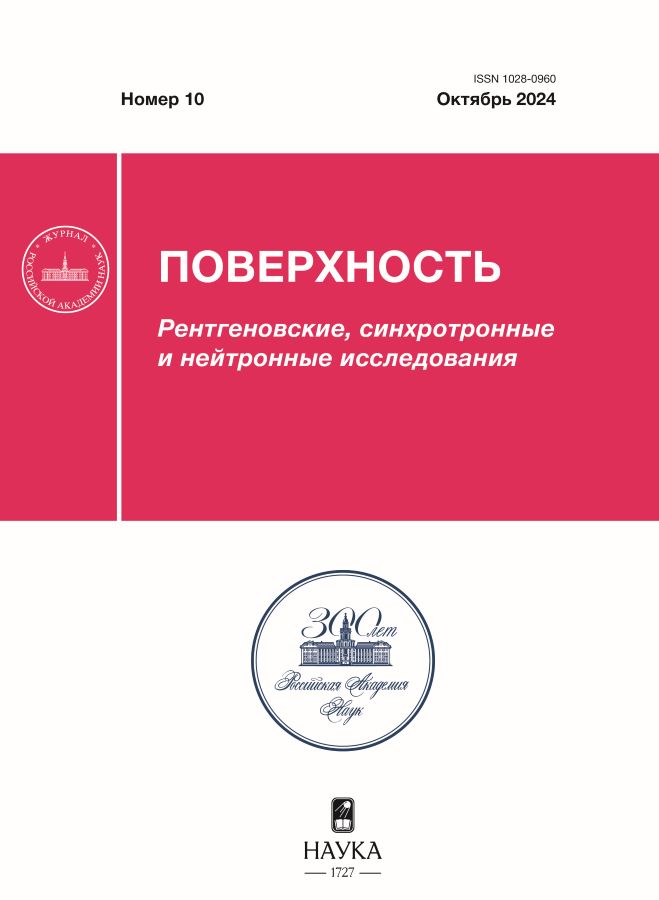Formation of ultra-smooth highly orientated ZnO films on amorphous surface (SiO2/Si) by magnetron sputtering
- Авторлар: Ismailov А.М.1, Guidalaeva Т.А.1, Muslimov А.E.2, Grigoriev Y.V.2, Kanevsky V.М.2
-
Мекемелер:
- Dagestan State University
- Kurchatov Complex of Crystallography and Photonics, National Research Centre “Kurchatov Institute”
- Шығарылым: № 10 (2024)
- Беттер: 9-16
- Бөлім: Articles
- URL: https://cardiosomatics.ru/1028-0960/article/view/664728
- DOI: https://doi.org/10.31857/S1028096024100029
- EDN: https://elibrary.ru/SHQRBK
- ID: 664728
Дәйексөз келтіру
Аннотация
The influence of temperature of amorphous SiO2/Si substrates on the formation of ultra-smooth highly oriented ZnO(0001) films by direct current magnetron sputtering has been studied. It has been shown that ZnO films obtained at a substrate temperature of 500°С have a lamellar shape of crystallites regardless of the growth rate in the range 1–7 nm/s. This feature of the crystallite morphology is associated with the minimum root-mean-square surface roughness of 0.9 nm for traditional high-speed deposition methods. The ultra-smooth surface of the films and the lamellar shape of the ZnO crystallites are mainly due to the two-dimensional mechanism of film formation under conditions of charging the growing surface in the magnetron discharge plasma.
Негізгі сөздер
Толық мәтін
Авторлар туралы
А. Ismailov
Dagestan State University
Email: amuslimov@mail.ru
Ресей, Makhachkala
Т. Guidalaeva
Dagestan State University
Email: amuslimov@mail.ru
Ресей, Makhachkala
А. Muslimov
Kurchatov Complex of Crystallography and Photonics, National Research Centre “Kurchatov Institute”
Хат алмасуға жауапты Автор.
Email: amuslimov@mail.ru
Shubnikov Institute of Crystallography
Ресей, MoscowYu. Grigoriev
Kurchatov Complex of Crystallography and Photonics, National Research Centre “Kurchatov Institute”
Email: amuslimov@mail.ru
Shubnikov Institute of Crystallography
Ресей, MoscowV. Kanevsky
Kurchatov Complex of Crystallography and Photonics, National Research Centre “Kurchatov Institute”
Email: amuslimov@mail.ru
Shubnikov Institute of Crystallography
Ресей, MoscowӘдебиет тізімі
- Özgür Ü., Alivov Y. I., Liu C., Teke A., ReshchikovM. A., DoğanS., Morkoç H. // J. Appl. Phys. 2005. V. 98. № 4. Р. 041301. https://doi.org/10.1063/1.1992666
- Borysiewicz M.A. // Crystals. 2019. V. 9. P. 505. https://doi.org/10.3390/cryst9100505
- Kołodziejczak-Radzimska A., Jesionowski T. // Materials. 2014. V. 7. № 4. Р. 2833. https://doi.org/10.3390/ma7042833
- Hu Y.-H., Chen Y.-C., Xu H.-J., Gao H., Jiang W.-H., Hu F.,Wang Y.-X. // Engineering. 2010. V. 2. № 12. Р. 973. https://doi.org/10.4236/eng.2010.212124
- Bach L.G., Nguyen N.G., Ho V.T. // Int. J. Photoen. 2016. V. 2016. Р. 1217576. https://doi.org/10.1155/2016/1217576
- Romero R., Leinen D., Dalchiele E. A., Ramos-Barrado J. R., Martin, F. // Thin Solid Films. 2006. V. 515. № 4. Р. 1942. https://doi.org/10.1016/j.tsf.2006.07.152
- Martin P.M., Good M.S., Johnston J.W., Posakony G.J., Bond L.J., Crawford S.L. // Thin Solid Films. 2000. V. 379. № 1–2. Р. 253. https://doi.org/10.1016/s0040-6090(00)01339-0
- Peverini L., Ziegler E., Bigault T., KozhevnikovI. // Phys. Rev. B. 2005. V. 72. P. 045445. https://doi.org/10.1103/PhysRevB.72.045445
- Gupta I., Mohanty B.C. // Sci. Rep. 2016. V. 6. № 1. Р. 33136. https://doi.org/10.1038/srep33136
- Пщелко Н.С., Водкайло Е.Г., Томаев В.В., Клименков Б.Д., Кошевой В.Л., Белорус А.О. // Изв. вузов. Химия и хим. технология. 2017. Т. 60. Вып. 8. С. 100. https://doi.org/10.6060/tcct.2017608.5649
- Vamsi K.K., Dutta V., Paulson P.D. // Thin Solid Films. 2003. V. 444. № 1–2. Р. 17. https://doi.org/10.1016/s0040-6090(03)00916-7
- Уразалиев У.С., Иванов Р.Д., Галкин Б.Д. // Электронная техника. 1970. Сер. 3. Вып. 3. С. 116.
- Исмаилов А.М., Эмирасланова Л.Л., Рабаданов М.Х., Рабаданов М.Р., Алиев И.Ш. // Письма в ЖТФ. 2018. Т. 44. Вып. 12. С. 52. https://doi.org/10.21883/PJTF.2018.12.46291.16792
- Larbah Y., Adnane M., Sahraoui T. // Mater. Sci.–Poland. 2015. V. 33. № 3. P. 491. https://doi.org/10.1515/msp-2015-0062
- Горелик Х.П., Хови А., Пэшли Д., Уэлан М. Электронная микроскопия тонких кристаллов. Москва: Мир, 1968. 574 с.
- Shcherbachev K.D., Voronova M.I. // Mater. Electronics Engin. 2022. V. 25. № 1. Р. 92. https://doi.org/10.17073/1609-3577-2022-1-92-102
- Александров Л.Н. Полупроводниковые пленки для микроэлектроники. Новосибирск: Наука, 1977. 248 с.
- Соловьев А.А., Захаров А.Н., Работкин С.В., Оскомов К.В., Сочугов Н.С. // Физика и xимия обработки материалов. 2009. № 2. С. 58. http://apelvac.com›f/38/93/2-2009.pdf
- Лютович А.С. Ионно-активированная кристаллизация пленок. Ташкент: Фан, 1982. 148 с.
- Mattox D.M. // J. Vac. Sci. Technol. A. 1989. V. 7. № 3. Р. 1105. https://doi.org/10.1116/1.576238
- Pentti N., Kapran A., Hama N., Martin Č., Zdeněk H., Henrik P., Daniel L. // J. Vac. Sci. Technol. А. 2024. V. 42. № 2. Р. 023006. https://doi.org/10.1116/6.0003408
- Бериш Р., Виттмак К. Распыление под действием бомбардировки частицами. Характеристики распыленных частиц, применения в технике. Вып. III. / Ред. Бериш Р., Виттмак К. Москва: Мир, 1998. 551 с.
- Данилин Б.С., Сырчин В.К. Магнетронные распылительные системы. М.: Радио и связь, 1982. 72 с.
- Debdyuti M., Sourav B. // Phys., Mater., Appl. 2022. V. 22. № 830. Р. 38. https://doi.org/10.3390/s22030820
- Xianglian L., Xuan C., Ziwei Y., He X., Chuanyu Z., Xueyong W. // Sens. Diagn. 2023. V. 2. P. 507. https://doi.org/10.1039/d2sd00203e
Қосымша файлдар













